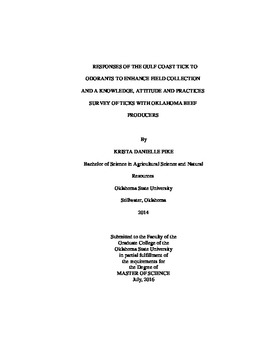| dc.description.abstract | The Gulf Coast tick, Amblyomma maculatum, Koch, is an arthropod of emerging medical, veterinary, and economic importance. Dragging, flagging, and CO2 trapping produce low capture rates despite populations existing within economic thresholds. Tick responses to host or conspecific associated chemicals were evaluated using a Y-tube olfactometer bioassay. Semiochemicals tested included ammonium hydroxide, squalene, 1-octen-3-ol, CO2, 2,6-dichlorophenol, 2-nitrophenol, and ear exudate and rumen fluid from cattle. We hypothesized that rumen fluid would be most attractive to A. maculatum ticks. Of all tested, only rumen fluid showed strong responses in the lab assays. Squalene (0.1%) had repellent properties and 2,6-dichlorphenol (5%) failed to attract any ticks. When field tested, rumen fluid did not demonstrate definable attraction. This was the first time rumen fluid was shown to be attractive to A. maculatum in a laboratory setting. Further research is needed to evaluate its role as a tick attractant, its potential to improve trapping success, and its role as a host cue facilitating parasitism of cattle. Additionally, farmers are a vulnerable population at increased risk for tick bites and tick-borne illnesses. Oklahoma beef producers (n=198) were surveyed to determine their attitudes, knowledge and perceptions about ticks and the risks they pose to cattle and humans, the tick prevention methods used, and where producers get information. Producers (68.9%) believed ticks were at most a moderate problem for cattle, whereas, only 42.1% thought ticks were only somewhat of a problem for people. Rocky Mountain spotted fever (78.7%) was of most concern for humans while only 9.3% indicated concern for ehrlichiosis. Respondents checked their body for ticks more often than wearing protective clothing. Chemical control methods were used most often to treat ticks on cattle and 30% use injectable dewormer. Veterinarians were the main source of information for producers. Most frequently requested additional information was for prevention and control of ticks on their cattle. Ticks were perceived to be a greater risk for cattle than for humans, though ticks vector more pathogens to humans in Oklahoma. This survey will assist in the development of educational tools used by extensions services. | |
